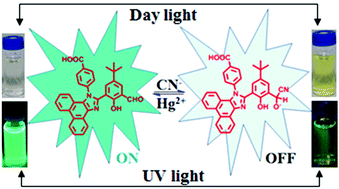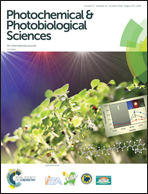Fluorescent imidazole-based chemosensors for the reversible detection of cyanide and mercury ions†
Abstract
We report 4-(2-(5-(tert-butyl)-3-formyl-2-hydroxyphenyl)-1H-phenanthro[9,10-d]imidazol-1-yl)benzoic acid 1 and 4-(2-(5-(tert-butyl)-3-formyl-2-hydroxyphenyl)-4,5-diphenyl-1H-imidazol-1-yl)benzoic acid 2 as reversible luminescent sensors for the detection of cyanide and mercury ions. These imidazole derivatives were characterized using spectroscopic techniques and single crystal X-ray crystallography. The compounds showed sensing exclusively towards CN− ions, which resulted in the quenching of fluorescence and a decreased singlet state life time. The detection limit of imidazole derivatives 1 and 2 were found to be 0.8 μM and 1.2 μM respectively, in a CH3CN/H2O system. Job's plot analysis, 1H NMR spectra and LC-MS studies supported the formation of the respective cyanohydrin. This cyanohydrin was further used as a reversible sensor for the detection of Hg2+ ions through metal-assisted elimination. The reversibility and reusability of sensors for the detection of CN− and Hg2+ ions were tested for four consecutive cycles.



 Please wait while we load your content...
Please wait while we load your content...